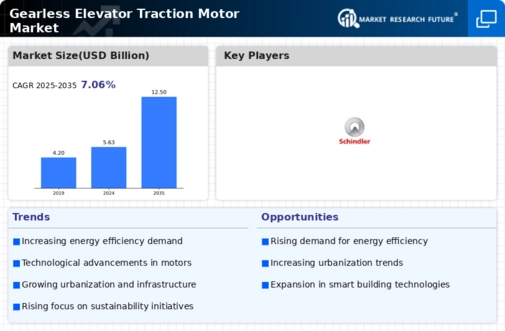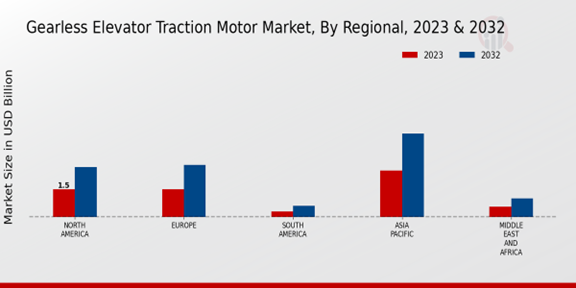Technological Advancements
The Global Gearless Elevator Traction Motor Market Industry is experiencing rapid technological advancements, particularly in the development of energy-efficient motors. These innovations not only enhance performance but also reduce energy consumption, aligning with global sustainability goals. For instance, the introduction of permanent magnet synchronous motors has significantly improved efficiency levels. As a result, the market is projected to reach 5.63 USD Billion in 2024, driven by the demand for eco-friendly solutions in urban infrastructure. This trend indicates a shift towards smarter building technologies, which could further propel the growth of the gearless elevator traction motor sector.
Increased Focus on Sustainability
Sustainability is becoming a central theme in the Global Gearless Elevator Traction Motor Market Industry. As environmental concerns grow, there is a heightened focus on reducing carbon footprints across various sectors, including construction. Gearless elevator systems are recognized for their lower energy consumption and reduced environmental impact compared to traditional systems. This shift towards sustainable practices is encouraging manufacturers to innovate and develop more efficient products. Consequently, the market is poised for growth, with projections indicating a potential increase to 12.5 USD Billion by 2035, driven by the global push for greener technologies.
Growing Demand for Smart Elevators
The rise of smart buildings is driving the demand for advanced elevator systems, including gearless traction motors, within the Global Gearless Elevator Traction Motor Market Industry. Smart elevators equipped with IoT technology enhance operational efficiency and user experience, making them increasingly popular in modern constructions. These systems can optimize energy usage and reduce wait times, appealing to both developers and end-users. As urban areas continue to adopt smart technologies, the market for gearless elevator traction motors is expected to expand significantly, aligning with the broader trend of digital transformation in the construction sector.
Regulatory Support for Energy Efficiency
Government regulations promoting energy efficiency are significantly influencing the Global Gearless Elevator Traction Motor Market Industry. Many countries are implementing stringent energy standards for elevators, encouraging the adoption of gearless systems that offer lower energy consumption. This regulatory environment is fostering innovation and investment in energy-efficient technologies. As a result, manufacturers are increasingly focusing on developing gearless traction motors that comply with these regulations. This trend is likely to contribute to a compound annual growth rate of 7.53% from 2025 to 2035, indicating a robust market response to regulatory pressures.
Urbanization and Infrastructure Development
Urbanization continues to be a major driver for the Global Gearless Elevator Traction Motor Market Industry. As cities expand and populations increase, the demand for high-rise buildings and efficient transportation systems rises. This trend is particularly evident in emerging economies where rapid urban development is occurring. The need for modern elevators equipped with gearless traction motors is becoming essential for meeting the demands of urban living. By 2035, the market is expected to grow to 12.5 USD Billion, reflecting the increasing investment in infrastructure projects worldwide, which further emphasizes the importance of advanced elevator systems.



